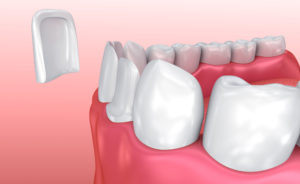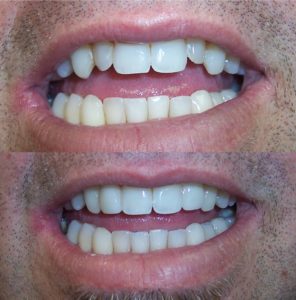Which Smile Problems Can Veneers Fix?
Porcelain veneers are a wonderful option for improving or even completely recreating your smile. They cover the visible surface of the teeth, allowing us to change the appearance and cover or mask many different smile problems. At Designer Smiles, our dentists have transformed thousands of smiles with veneers.
How Do Veneers “Fix” Smiles?
 Because veneers replace the visible portion of teeth, and because we have control over their shape, color, and size, we can completely change the appearance of someone’s smile. Veneers do not move the underlying teeth, so the existing position of teeth affects the final outcome. We’ll get to that in the section covering smile problems that veneers cannot fix. Let’s start with the ones they can fix.
Because veneers replace the visible portion of teeth, and because we have control over their shape, color, and size, we can completely change the appearance of someone’s smile. Veneers do not move the underlying teeth, so the existing position of teeth affects the final outcome. We’ll get to that in the section covering smile problems that veneers cannot fix. Let’s start with the ones they can fix.
Which Smile Problems Can Veneers Fix?
In general, veneers can fix most smile problems that are purely cosmetic. This means that veneers do not fix smile problems that stem from underlying disease, like cavities and gum disease. Veneers are also limited by the existing position of a tooth, so you will notice that in some of the problems described below, we use the term mild or minor.
Discolored Teeth that do Not Respond to Teeth Whitening
 Some teeth do not respond well to teeth whitening. In cases where you have tried to whiten your teeth and are unhappy with the results, you should consider porcelain veneers. In a way, porcelain veneers are a form of permanent teeth whitening. When a dental lab technician makes porcelain veneers, the final step is glazing the porcelain. This glaze creates the smoothest, shiniest possible surface, which is resistant to external stains. Porcelain has a higher resistance to staining than tooth enamel and all other dental materials.
Some teeth do not respond well to teeth whitening. In cases where you have tried to whiten your teeth and are unhappy with the results, you should consider porcelain veneers. In a way, porcelain veneers are a form of permanent teeth whitening. When a dental lab technician makes porcelain veneers, the final step is glazing the porcelain. This glaze creates the smoothest, shiniest possible surface, which is resistant to external stains. Porcelain has a higher resistance to staining than tooth enamel and all other dental materials.
In cases of severe internal staining, like that caused by tetracycline antibiotics, the veneer process involves removing the outer layer of enamel. This added thickness of porcelain helps block the underlying dark color and prevents it from showing through the veneer.
Minor Crowding
If your teeth have minor crowding, veneers can give the appearance of perfectly straight teeth. The word “minor” is important here. If there are areas with teeth overlapping or severely rotated teeth, veneers will not give a flawless appearance. When teeth have major rotations or overlapping, it causes them to appear narrower. Veneers are unable to widen those teeth while they remain in their crowded state.
If your teeth show severe crowding, Dr. Ann and Dr. Lauren will likely discuss the option to straighten then first with Invisalign. Some people actually find that they do not need veneers once the teeth are straight! Others find that Invisalign corrects the severe crowding so that veneers are a great option.
Minor Spacing or Gaps
Similar to the crowding discussed above, minor spacing or gaps are a simple problem to fix with veneers. Our dentists are experts at smile design. This means they know the proper size of teeth for each person’s unique face and smile. When considering gaps between the teeth, the size of the gap determines the width of the porcelain veneers necessary to hide or “close” the gaps. If the gaps are large, closing them with veneers would make the teeth look much too wide and give an unnatural appearance to the smile. Dr. Ann and Dr. Lauren take precise measurements in order to determine the final veneer size. They can even do a trial to see if the width gives a natural appearance while closing all of the spaces.
Again, if the spaces are too large, you can opt to close them with Invisalign. You even have the option to just partially close the spaces, getting them small enough so that veneers can produce a beautiful result.
Chipped and Uneven Teeth
Over time, teeth may chip or shorten on the biting surface as a result of nighttime clenching or grinding. If the bottom edge of your upper front teeth looks jagged or uneven, veneers can rebuild what was lost.
The most important thing to understand about this smile problem and fixing it with veneers is that the veneers themselves are at risk for the same chipping or wear. If you exhibit signs of nighttime clenching or grinding, Dr. Ann and Dr. Lauren will make you a nightguard to protect your new smile. Your job is to wear it every single night! If you do not, you might chip or dislodge your new porcelain veneers.
Teeth that are Misshapen or Too Small
 There are many cases of teeth developing in sizes or shapes that do not fit with the rest of the smile. Often the lateral incisors, the teeth on both sides of your front two teeth, are very small or shaped like a small peg. People with this tooth development abnormality are very aware that these teeth look “funny”, and they hate it. Veneers are the perfect solution to reshape and resize an abnormal tooth or teeth. Talk to Dr. Ann and Dr. Lauren about how you can use veneers to correct teeth like this.
There are many cases of teeth developing in sizes or shapes that do not fit with the rest of the smile. Often the lateral incisors, the teeth on both sides of your front two teeth, are very small or shaped like a small peg. People with this tooth development abnormality are very aware that these teeth look “funny”, and they hate it. Veneers are the perfect solution to reshape and resize an abnormal tooth or teeth. Talk to Dr. Ann and Dr. Lauren about how you can use veneers to correct teeth like this.
Which Smile Problems Cannot be Fixed with Veneers?
As implied earlier, there are some problems that veneers alone are unable to correct. In most cases, additional treatment is necessary to achieve your smile goals. This just means you need to have a detailed conversation with Dr. Ann and Dr. Lauren about which dental treatments can meet your goals.
Severe Crowding or Spacing
Because severe overlapping, rotation or gaps limit the width of the proposed veneers, it is not the treatment of choice for correcting these orthodontic problems. Rather than attempting to make teeth look to skinny or too wide because of the restrictions of the underlying tooth position, moving the teeth with Invisalign or other orthodontic treatment will lead to the best results for your smile.
Extensive Tooth Decay
Porcelain veneers are small and thin. They require a strong underlying tooth for support and longevity. If there is extensive decay (large cavities) on the front teeth, their weakened state makes them poor candidates for veneers. The teeth will require a much stronger option, like full porcelain crowns.
Missing Teeth
We cannot anchor fake teeth to veneers like a bridge. If you have any missing teeth visible in your smile, talk to Dr. Ann and Dr. Lauren about replacing them with dental implants. We are able to create the most natural appearance for replacement teeth with implants and can blend them into your dream smile perfectly.
Gummy Smile
When excess gum tissue is present, veneers alone will not change the appearance of a gummy smile. An additional treatment, called crown lengthening or gingivectomy, is necessary to move the gumline to its appropriate position. Then if you would like to change the appearance of the teeth themselves, you can proceed with porcelain veneers.
Loose Teeth or Gum Recession
Porcelain veneers require a firm foundation for long-term success. If you have severe gum recession or looseness of any of the front teeth, that must be treated first before any cosmetic treatment begins. That does not mean veneers will never be an option for you. You just need healthy gums and bone first.
More Questions about Veneers?
Call Designer Smiles today to schedule a veneer consultation with Dr. Ann and Dr. Lauren. They can answer any questions you have and help you determine if veneers are the right treatment option to help you meet your smile goals.
